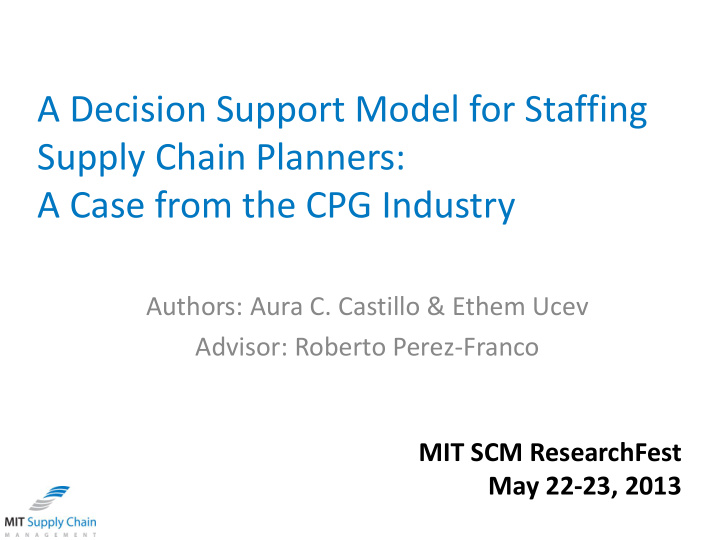



A Decision Support Model for Staffing Supply Chain Planners: A Case from the CPG Industry Authors: Aura C. Castillo & Ethem Ucev Advisor: Roberto Perez-Franco MIT SCM ResearchFest May 22-23, 2013
Agenda • Research Question • Motivation • Methodology • Analysis • Conclusions • Recommendations May 22-23, 2013 MIT SCM ResearchFest 2
Background Why Centralization? • Economies of scale • Control • Standardization May 22-23, 2013 MIT SCM ResearchFest 3
Research Question What is the right number of planners? May 22-23, 2013 MIT SCM ResearchFest 4
Motivation • Increased visibility • Adaptability to changes • Costs of under/over staffing • Employee morale and productivity May 22-23, 2013 MIT SCM ResearchFest 5
Methodology • Site visit • Interviews Qualitative • Identification of workload factors • Templates for data collection • Statistical method and software selection Quantitative • Data analysis and Model May 22-23, 2013 MIT SCM ResearchFest 6
What factors influence planner’s workload? Variables analyzed: Scheduling Complexity 1. Rescheduling Messages 2. Number of Resources Master Data Complexity 3. MD Complexity 4. Scheduling Complexity 5. Initiatives 6. Manufacturing Sites 7. Number of Codes Number of codes 8. Supplier Schedule Performance 9. MAPE 10.Number of Contractors 11.Flexibility and Responsiveness 12.Forecasted tightness of supply chain capacity 13.Avg days IOH May 22-23, 2013 MIT SCM ResearchFest 7
7 of the variables analyzed are relevant, while 2 show very low prediction power Results using bivariate correlation May 22-23, 2013 MIT SCM ResearchFest 8
R 2 = 99% - Running multiple regression with all variables as predictors • Hypothesis: The independent variables used in this model have an effect on the number of planners. • Null Hypothesis: All effects are zero. Adjusted R 2 = 99.5% F-ratio = 1,871 Probability > F = <0.0001* May 22-23, 2013 MIT SCM ResearchFest 9
The initial model is not statistically valid Normal distribution of residual Multicollinearity among independent plots variables - p-values>0.05 Evidence of heteroscedasticity May 22-23, 2013 MIT SCM ResearchFest 10
The 4 most powerful predictors according to Stepwise Regression 1. Rescheduling messages 2. Master Data complexity 3. Number of contractors 4. Flexibility and responsiveness Adjusted R 2 = 98% F-ratio = 1,001.8 Probability > F = <0.0001* May 22-23, 2013 MIT SCM ResearchFest 11
The final model is statistically significant Normal distribution of residual No evidence of multicollinearity among plots independent variables - p-values < 0.05 Parameter Prob>|t| VIF Intercept <.0001 1-Rescheduling Messages <.0001 5.94 3-MD Complexity[2-1] <.0001 8.20 3-MD Complexity[3-2] <.0001 3.14 3-MD Complexity[4-3] <.0001 4.84 3-MD Complexity[5-4] <.0001 3.08 No evidence of heteroscedasticity 10-Number of Contractors <.0001 6.03 11-Flexibility and Responsiveness[2-1] 0.006 2.41 11-Flexibility and Responsiveness[3-2] 0.001 2.86 11-Flexibility and Responsiveness[4-3] <.0001 7.33 11-Flexibility and Responsiveness[5-4] <.0001 8.99 May 22-23, 2013 MIT SCM ResearchFest 12
Final mathematical model 𝐹𝑡𝑢𝑗𝑛𝑏𝑢𝑓𝑒 𝑜𝑣𝑛𝑐𝑓𝑠 𝑝𝑔 𝑞𝑚𝑏𝑜𝑜𝑓𝑠𝑡 = 21.5 + 0.0008 × 𝑆𝑓𝑡𝑑ℎ𝑓𝑒𝑣𝑚𝑗𝑜 𝑁𝑓𝑡𝑡𝑏𝑓𝑡 0 1 => − 9.38 2 => − 13.7 3 => + 𝑁𝐸 𝐷𝑝𝑛𝑞𝑚𝑓𝑦𝑗𝑢𝑧 × + 0.27 × 𝑂𝑣𝑛𝑐𝑓𝑠 𝑝𝑔 𝐷𝑝𝑜𝑢𝑠𝑏𝑑𝑢𝑝𝑠𝑡 − 11.05 4 => − 14.18 5 => 𝑜𝑝𝑢ℎ𝑗𝑜 𝑓𝑚𝑡𝑓 0 1 => 1.22 2 => 2.49 3 => + 𝐺𝑚𝑓𝑦𝑗𝑐𝑗𝑚𝑗𝑢𝑧 𝑏𝑜𝑒 𝑆𝑓𝑡𝑞𝑝𝑜𝑡𝑗𝑤𝑓𝑜𝑓𝑡𝑡 × 17.61 4 => 2.65 5 => 𝑜𝑝𝑢ℎ𝑗𝑜 𝑓𝑚𝑡𝑓 May 22-23, 2013 MIT SCM ResearchFest 13
Conclusions • This reduced model could serve as a tool to estimate the number of production and material planners • Results contrary to what common sense would suggest (number of SKUs or complexity of the supply chain).The most critical predictors are: • The number of rescheduling messages • Master data complexity • Number of contractors • Flexibility and responsiveness of the supply chain These factors explained more than 98% of the variance in the required number of planners. May 22-23, 2013 MIT SCM ResearchFest 14
Recommendations • Tracking of data is necessary in order to avoid estimation of data points. • Elimination of variables - We recommend finding an alternative way to measure Forecasted tightness of supply chain capacity for future analyses. May 22-23, 2013 MIT SCM ResearchFest 15
Recommend
More recommend